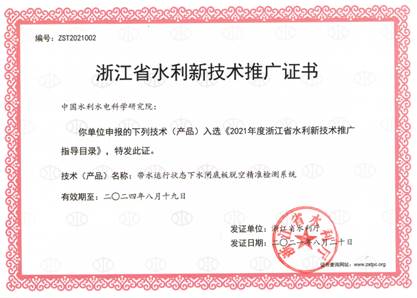Main Participants: LI Songhui, ZHANG Yan, HU Junhua, LIU Ruiqiang, LUO Xiangyu, LIU Xunnan, YAN Weishuo, BAI Bing, ZHANG Ruixue, CUI Jianghuan, HAN Shasha, ZHANG Mengwei
Concrete structures are mostly placed in complex multi-layered structures. Under the complex conditions due to engineering construction and long-term operation, voids are prone to form at the interface of concrete structures. These defects often occurs in concealed areas that are difficult to be discovered. The void at the interface of concrete structures is one of the important factors that affect the duration and engineering safety of the structures. Such voids can be rapidly detected using electromagnetic techniques in a waterless environment or in plain concrete structures. However, due to the strong absorption or shielding of electromagnetic signals by water or metal structures, these voids can hardly be detected accurately underwater or in steel plate (lined) concrete structures. We could use the dynamic parameter method to diagnose the overall structural damage with the environmental or external input as incentives, but the detection results are significantly influenced by the number and locations of sensors. Therefore, there is a pressing need to develop and research on non-destructive diagnostic techniques for concrete interface voids in complex multi-layered structures, especially in environment with water or with steel structures.
· Research on the dynamic numerical simulation model and high-efficiency algorithm for concrete interface void in complex multi-layered structures;
· Research on the wave field characteristics of elastic wave transmission in multi-layered structures;
· Research on the dynamic sensitive feature quantity and efficient and accurate recognition algorithm reflecting void defects;
· Research and development of a complete set of equipment and software systems for non-destructive detection of interface void in concrete structures;
· Full-scale model tests on thick steel shell concrete and physical model tests on sluice structures.
· Having established the dynamic numerical equation, coupled constitutive model and efficient solution algorithm for complex multi-layered structures, revealing the wave field characteristics of elastic wave propagation in multi-layered, multi-phased medium under complex environments, providing theoretical support for non-destructive diagnosis of concrete interface void in complex multi-layered structures.
· Having proposed the dynamical sensitive indicators reflecting void defects at concrete interfaces, established an optimal mathematical model and a machine learning model for non-destructive void diagnosis under nonlinear mapping relation, enabling the efficient and accurate identification of concrete interface void defects in complex multi-layered structures, with a validated coincidence rate of 91%.
· Having developed the intelligent non-destructive detection equipment and software system for concrete interface void in multi-layered structures featuring intelligent acquisition, real-time analysis and visual display. The detection equipment consists of a contactless elastic wave detection device at the bottom plate of sluices operating in water environment, as well as an intelligent device for elastic wave detection in steel shell concrete structures.
This technology has been awarded the Certificate of Advanced and Practical Water-related Technology for Prioritized Promotion and the Certificate of New Water-related Technology for Promotion in Zhejiang Province. This technology has been successfully applied to the world's largest deep-sea immersed steel-shell concrete tube tunnel project of the Shenzhen-Zhongshan Channel, with a total of 70,436,627 detection points arranged, providing strong support for the high-quality construction of the project. It has also been adopted in as many as 20 sluices and 12 tunnel projects in Guangdong Province, Xiong'an New Area in Hebei Province, Shandong Province, and other regions, ensuring the long term safety operation of these projects.
Figure 1 Wave Field Characteristics of Typical Multi-layer Structures
Figure 2 Underwater Structure Detection Equipment and Onsite Application
Figure 3 Detection Equipment for Steel Shell Concrete Structures and Onsite Application
Figure 4 Detection Software and Results

Figure 5 Certificate of Advanced and Practical Water-related Technology for Prioritized Promotion

Figure 6 Certificate of New Water-related Technology for Promotion in Zhejiang Province